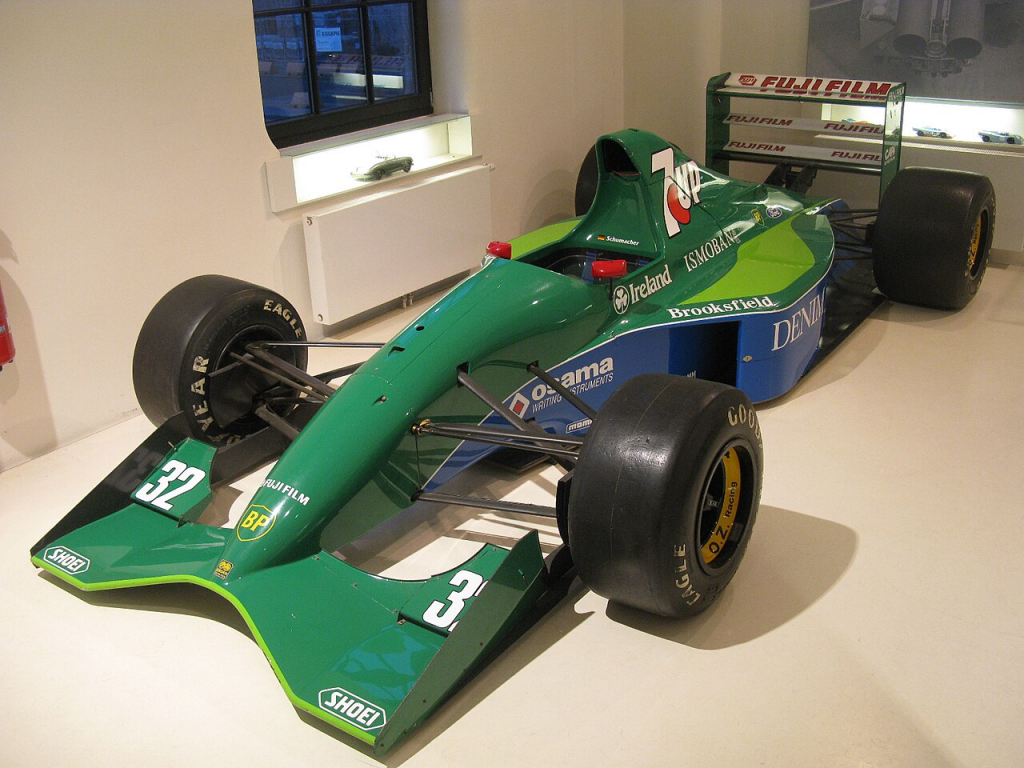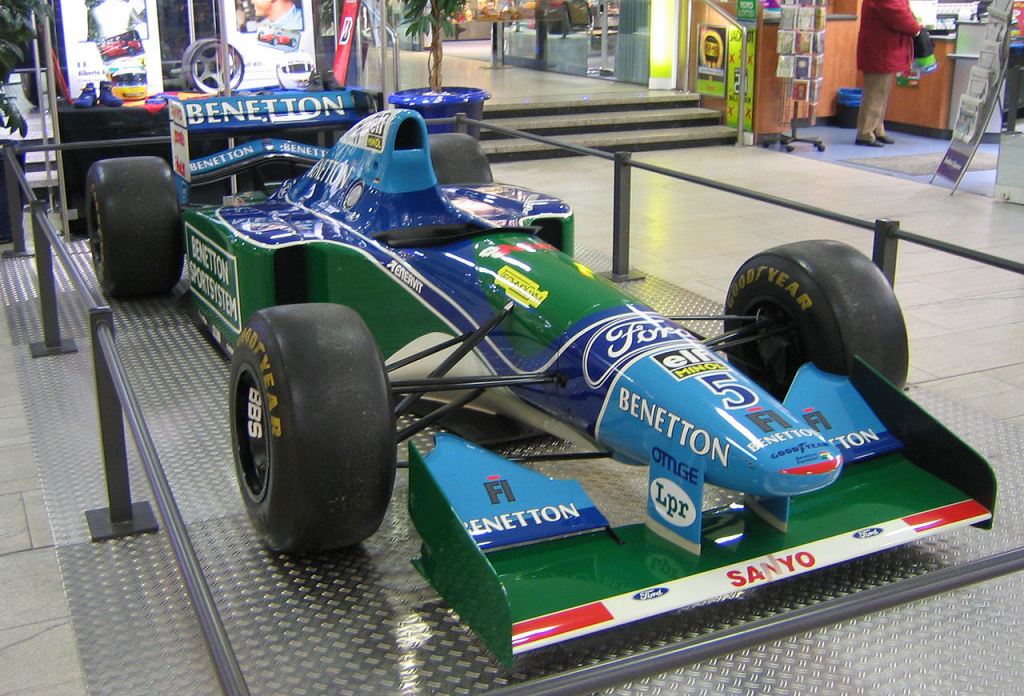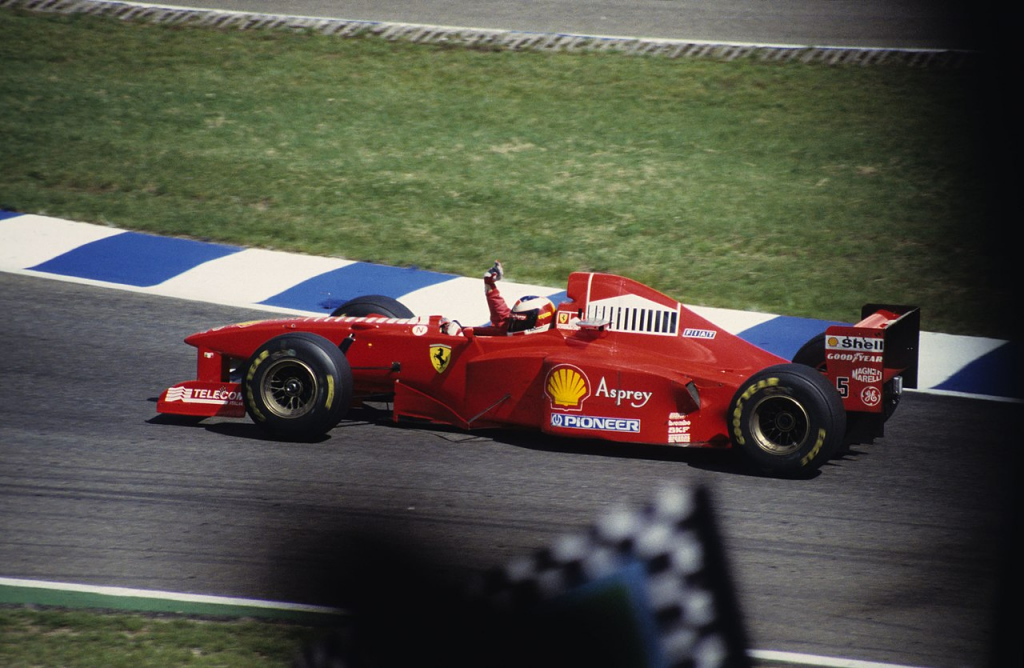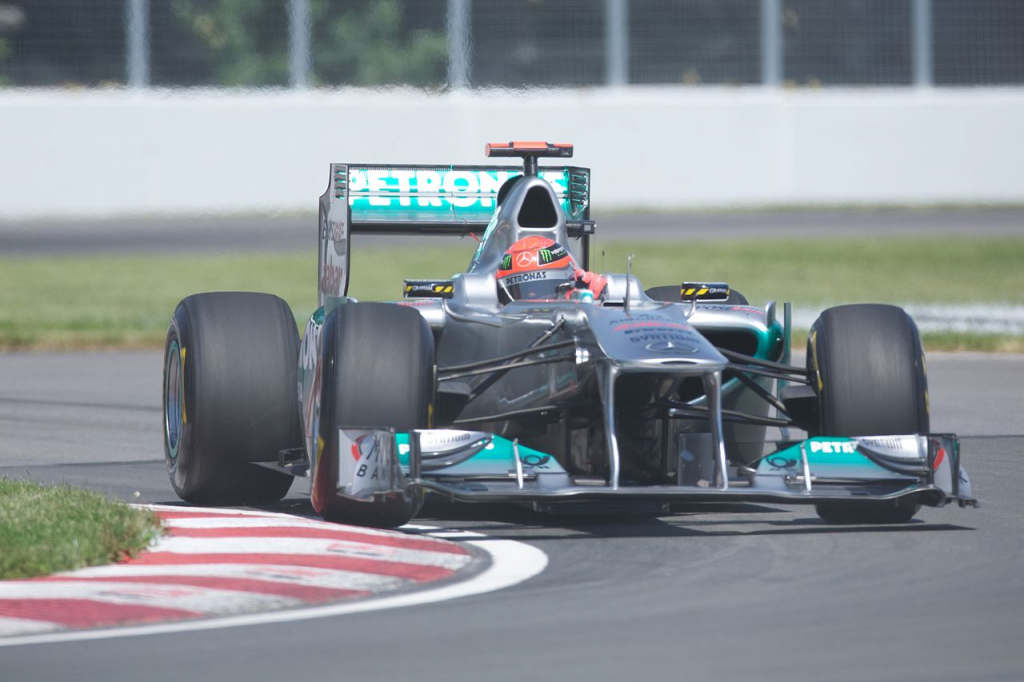F1 Legends: Michael Schumacher

Has there ever been a Formula 1 driver as meticulous as Michael Schumacher? Has any driver been prepared to put in so much work in developing a team into something truly special? Schumacher, the original seven-time world champion, set records that at one stage looked far beyond the reach of anyone, and to this day his is a legacy of speed, talent… and a sprinkling of controversy.
A Humble Start
Born in 1969 to working class parents, Schumacher happened to have a mother and father who both had an association with karting. His father was a bricklayer who ran a local karting track, and his mother ran the track’s canteen. At the age of four Schumacher’s pedal kart was fitted with a small petrol engine, and at the age of six, he was racing competitively, and winning as well. By the time he was a teenager, he was competing in various feeder series, and winning them as well. He used some of the prize money to pay off the debts his parents had accrued to help fund his fledging career.
During this period, we also saw glimpses of a darker side to Schumacher. In 1991, whilst racing at a 430 km event at the Nürburgring, Schumacher was involved in a contentious collision with former F1 racer Derek Warwick. Schumacher lost time during his qualifying lap behind the Briton, and in anger, deliberately swerved into him. This damaged Warwick’s car, and he went looking for Schumacher after the race. It took several mechanics, and Schumacher’s teammate Jochen Mass, to prevent things getting violently physical.
1991 was also the year that Schumacher made his Formula 1 debut, and changed the course of the sport.
Early Team-Hopping
Michael Schumacher had placed himself on the F1 radar through his performances in the feeder series’, and in 1991 he got an opportunity when anther driver was jailed. Schumacher would make his debut at the 1991 Belgium Grand Prix, for the Jordan team. He had not raced at Spa before, so he took a pedal bike around the circuit to help him learn what was in store. He qualified a highly-respectable seventh, quite the feat, considering the limitations of the Jordan 191 car.

Whilst his debut race ended with clutch failure on the first lap, Schumacher’s devotion to learning the track, and his pace in qualifying, combined with his record in the feeder series’, was enough to earn him the attention of the Benetton team. Benetton approached Schumacher immediately, and poached him from Jordan for the very next race! This led to a brief effort by Jordan to prevent this, but as Schumacher had not yet finalised a contract with Jordan, the case failed. Schumacher would conclude the 1991 season as teammate of three-time champion Nelson Piquet, and the young German was not at all intimidated by the experience and record of the Brazilian. In fact, Schumacher would out-qualify Piquet four times out of five, and virtually matched him on points over that period. Some credit Schumacher’s performances as persuading Piquet it was time to retire, as the newcomer was threatening to eclipse him from the very start.
For 1992, Schumacher remained with Benetton, though further contractual wrangles meant he was nearly snapped up by the Sauber team. The idea was that if Mercedes entered F1, Sauber would have the right to sign Schumacher, but Peter Sauber decided against forcing the move, as Schumacher did not desire a move, and there would be no benefit to having a grumpy driver on the books. Instead, Schumacher would be paired with veteran Englishman Martin Brundle at Benetton, and in his first full season, he showed some of the qualities that would make him a superstar. In his first four races, and despite contending with the likes of Senna and Mansell, Schumacher finished on the podium three times. In total, he finished on the podium eight times in 16 races, and this included claiming his maiden win, at the venue of his debut a year earlier, Belgium.

1993 followed a similar pattern of regular podiums, whenever Schumacher finished a race. Whilst the car could not compete with the dominant Williams team, and whilst Ayrton Senna was driving the wheels off an average McLaren, Schumacher nonetheless held his own against the established stars of the era, and took his second victory, at the Portuguese Grand Prix.
Tragedies and Triumphs
1994 will always be a year that F1 fans reflect upon. It began with the shocking, tragic deaths of Roland Ratzenburger and Ayrton Senna, at the San Marino Grand Prix. It saw controversy over the regulation changes, which some argued destabilised the cars. Some also argued that Benetton and Schumacher were bending the rules, though this was never proven.
What was clear is that Benetton had emerged as the closest challengers to the powerful Williams team. That being said, the B194 was said to be difficult to drive, and Schumacher had three different teammates (including Jos Verstappen, father of Max) over the course of the year. In Schumacher’s hands, the car proved to be extremely quick, and he won six of the first seven races of the season, including lapping everyone at the Brazilian Grand Prix. He came second in Spain, despite the car being stuck in fifth gear for much of the race.
I mentioned before that controversy proved to be an element of Schumacher’s career, and 1994 certainly showed that. At the British Grand Prix, Schumacher’s gamesmanship cost him dearly. He overtook pole-sitter Damon Hill on the formation lap, something forbidden by the regulations. He then refused to serve a five-second penalty within three laps, again as required by the rules. He was then given a black flag, disqualifying him from the race, and it was only then that he served the penalty. Benetton tried to negotiate their way out of the disqualification during the race, but the decision was upheld, and whilst he crossed the line second, Schumacher picked up no points at Silverstone. For ignoring the black flags, he was also banned for the next two races, though as the team appealed, he was able to take part in those races.
He wound up retiring from his home race in Germany with engine failure, but potential title rival Hill failed to score any points. He went on to win in Hungary, and at that stage his title lead looked tremendous. However, his rule-breaching behaviour at Silverstone came back to haunt him, and not before his win in Belgium was scrubbed, due to the car’s bottom board wearing away too much. Hill would claim the win at Spa, and win the races in Italy and Portugal, bringing Schumacher firmly into his sights. Schumacher took a much-needed win at the European Grand Prix, but Hill’s win in Japan meant just one point separated the two, going into the final round.
For the finale in Australia, the equation was simple. If Schumacher finished ahead of Hill, he was champion. If Hill won the race, he would be champion. The pair raced clear of the pack, and Hill loitered behind Schumacher, close but unable to pass. This situation remained the state of affairs after the pit stops, and the title was on a knife-edge. Then, on lap 35, Schumacher made a mistake. He ran wide at a corner, and brushed the wall. He re-joined the track with Hill right behind him, sensing an opportunity. Hill dove down the inside of the next corner, Schumacher turned in hard, and the two connected. Schumacher’s car was bounced into the air, and he retired on the spot. Hill initially limped back to the pits, but broken suspension meant his race was over too. Schumacher was world champion.
The 1995 season saw Schumacher remain with Benetton, and claim a second title. This one came more easily; Schumacher knew what it took to win, and the Benetton car sung under his administration. He won nine races, and secured the championship with two races to spare. His star was not merely rising; Schumacher had claimed the mantle of best driver on the grid, by some margin.

Turning Red
In a move that came as something of a surprise, Schumacher elected to sign for Ferrari in 1996. At that stage, Ferrari had slipped from their status as F1 supremoes, winning only two races between 1991 and 1996. The last year they had looked competitive had been in 1990. They had last won the constructor’s championship in 1983. Their sharp fall from their pinnacle could not be overstated.
The car Schumacher had for 1996 was regarded as a pig’s ear. The F310 was quick at points, but not enough to overcome the Williams FW18, and it lacked reliability. Nonetheless, Schumacher won three grands prix that year, including what has historically become regarded as one of the finest drives of any F1 racer ever. The 1996 Spanish Grand Prix was held in wet conditions, and Schumacher loved those conditions. Though he slipped from third to sixth at the start, he scythed his way up the field, taking the lead on lap 19, and he would lap five seconds faster than the rest, eventually lapping everyone up to third place, on his way to his first Ferrari win.
Ferrari retained the F310 for 1997, and lured Ross Brawn (Benetton’s technical director) and Rory Byrne (designer) to the team, at Schumacher’s urging. They all got to work on redeveloping the car, transforming an average car’s fortunes, and the team’s in the process. The F310B was a car that Schumacher could compete in, and he did exactly that. Whilst the Williams of Jacques Villeneuve was the favourite, Schumacher was swiftly exchanging wins with the Canadian, and many felt he was outperforming relative to the car. Such was the performance that he was in contention for the championship going into the final race, held at the Jerez circuit in Spain.

Here, the controversial, unsporting element of Schumacher’s driving would rear its head once more. He led Villeneuve by one point heading into the final race, so if he finished ahead, he would win his third world title. He got ahead of his rival at the start, and led the race for many laps. A car issue slowed him, and Villeneuve began to assert himself, catching up, until he attempted to pass on lap 48. Darting down the inside of the tight right hairpin of turn six, Villeneuve looked set to seize the lead. Schumacher turned into the Williams, banging the side of his rival’s car, but unlike in 1994, only Schumacher ended up retiring. Villeneuve, despite damage to his car, went on to finish third, and won the championship. A steward’s enquiry ruled Schumacher had deliberately turned in on Villeneuve, and he was disqualified from the 1997 championship. His wins, pole positions, fastest laps and points were allowed to remain part of his racing record.
It was impossible not to view the 1994 incident with Hill in a new light. Question marks had always lingered; now there had been a repeat, this time with a clear judgement from the authorities, one Schumacher did not dispute. He admitted to making a mistake, though he denied he had deliberately struck Villeneuve’s car. He referred to the event as a ‘misjudgement’. Nonetheless, in his native Germany and Ferrari’s native Italy, Schumacher’s reputation had been tarnished.
The Most Respected Opponent
Despite a few calls for Schumacher to be sacked, he remained with Ferrari for the 1998 season, and with Williams not producing a competitive car, the mantle fell to McLaren and Mika Hakkinen to provide the challenge. The pendulum would swing back and forth throughout the year, with Hakkinen realising his own potential, after several years in the sport. Of the 16 races, all but two were won by either Hakkinen or Schumacher. Schumacher himself won six grands prix, but his challenge for the title was impacted by a spectacular crash with Hakkinen’s teammate David Coulthard at the Belgian Grand Prix, an incident that saw Schumacher go into the back of a slowing Coulthard as the Scot prepared to let Schumacher lap him. Schumacher remarkably drove back to the pits on three wheels, and then, with a face like thunder and fury in his veins, went to the McLaren garage to confront Coulthard. Mechanics from both teams prevented a much more physical remonstration!
In the end, Schumacher took the title fight to the last race, but he was trailing Hakkinen, and he did not help matters by stalling off the line. A burst tyre ended his race, marking the second year in a row he would be runner-up. 1999 also failed to deliver success; following a strong start to the season, Schumacher suffered a brake failure at speed at the British Grand Prix, hitting a wall, and breaking his leg. The injury ruled him out until the penultimate race, thus ending his title charge. His second places at those last two races did help to secure Ferrari’s first constructor’s championship since 1983.
In 2000, Schumacher started his sixth season with Ferrari, and started with three consecutive wins, gaining a significant lead over Hakkinen, who retired from the first two races. In fact, Schumacher won five of the first eight races, whilst Hakkinen won only once. A spell of four retirements in five races dented Schumacher’s title charge, and saw Hakkinen make up serious ground. Schumacher would also finish behind Hakkinen at Hungary, and was beaten in a brilliant battle at Belgium, which featured a defining pass down the Kemmel Straight. As Schumacher and Hakkinen approached a backmarker, Hakkinen switched to the inside of the backmarker, Schumacher swept around the outside, and for a split second there were three cars hurtling down one of the fastest sections of race track in the world.
Hakkinen took the lead, won the race, and claimed the lead in the championship, but Schumacher would win next time out in Italy, delighting the Ferrari faithful, and retook the lead in the title standings. In the process, he equalled Senna’s record of 41 victories, and upon being told, Schumacher broke down in tears. He would later explain his reaction was due to recalling the tragic events of 1994. The scene itself was as iconic as any moment in Schumacher’s career.
Now leading the title fight, he would not relinquish the lead, and would win the next two races, in doing so claiming his third world championship. He would also win the final race of the year, capping off a brilliant campaign. It marked the first time a Ferrari driver had won the championship since 1979.
The Glory Years

With his third title secured, Schumacher now displayed another of his defining traits: a determined focus, and hunger to win. His drive to gain more success, more glory, knew no limits. With Ferrari very much in their groove in terms of car design, and Schumacher’s confidence as high as ever, what followed was, at the time, unprecedented in Formula 1. He was largely untroubled in 2001, winning nine races, and claiming nearly double the points total of runner-up Coulthard. In 2002 he produced arguably the most dominant F1 season in history, crushing all opposition, winning 11 times, and not only scoring points in every race, but finishing on the podium too. In doing so, he equalled Juan Manuel Fangio’s record of five world championships, but he was not done.
If Schumacher had been untouchable in 2001 and 2002, he showed he still knew how to fight for a championship in 2003. In a season where the pendulum would swing several times, Schumacher duked it out with the McLaren of Kimi Raikkonen, and the Williams of Juan Pablo Montoya. Incredibly, Schumacher would win six races, but Raikkonen would take the title battle to the wire, despite only winning once! Consistency from Raikkonen held him in the fight, but in the end, Schumacher’s experience paid off. Raikkonen needed to win at the finale in Japan to have any chance of the title, and needed Schumacher to fail to score points, but he could only manage second, and Schumacher’s eighth place was enough to carry him over the finish line. His sixth title also meant he was now indisputably the most successful driver in Formula 1.
If 2003 had been a fight, 2004 was not. It was another display of utter dominance from Ferrari and Schumacher. He won 12 of the first 13 races of the season, and secured the title at the 14th of 18 rounds with second place in Belgium. His performances were absurdly good. Now a seven-time world champion, what would come next?
All Good Things
In any sport, indeed any aspect of life, and certainly in the madcap technical world of Formula 1, nothing lasts forever. Success can be sustained for a time, but not forever. Between new, hungry blood, and new regulations, 2005 marked the end of Schumacher’s and Ferrari’s control over Formula 1. In a season contested by the Renault of Fernando Alonso and the McLaren of Kimi Raikkonen, Schumacher would take only one win, at the controversial US Grand Prix at Indianapolis. Fears over tyre blowouts restricted the race to just six runners, including the Ferraris, and Schumacher would cruise to the strangest win of his career.
2006 would be Schumacher’s last year with Ferrari, and he would announce his retirement from Formula 1 during a season that seemed to take place in two halves. Alonso controlled the first half of the campaign, winning six of the first nine races, with three second places. Schumacher, who had won two of those other races, would also win five of the next seven rounds. With his win in China, he took the 91st and final victory of his career. The title fight technically ran to the final race after Schumacher retired in Japan, but Alonso needed a point, whereas Schumacher had to win. Alonso’s second place meant Schumacher would end his career as runner-up, but also as an incredible seven-time world champion, smashing records in a manner that at the time was as surreal as it was powerful.
Not the End
In 2010, Schumacher made a somewhat surprising return to Formula 1, announcing his involvement with the newly-formed Mercedes team. He declared his intention to fight for championships, but during his three-year spell at Mercedes, success proved hard to come by. It could be argued that he had lost his edge in the years out from the sport, as he struggled to come to terms with the revised cars. Whilst he would gain the occasional podium, and even a brilliant pole at Monaco in 2012 (a grid penalty denied the chance to start at the front), he would never regain the clinical, competitive edge that had defined so much of his career.

With his final retirement at the end of 2012, Schumacher paved the way for Lewis Hamilton to sign for Mercedes. Sadly, Schumacher would not get to enjoy his retirement for very long. In December 2013, he suffered a serious head injury whilst skiing. He was placed into a coma for several months, and was eventually moved to his home, where he has been ever since. His family have closed ranks, protecting his privacy, which is absolutely right. It is incredibly unfortunate that someone to have had such a glittering career could be rendered so wounded, and my hope for him and his family is that somehow, behind the scenes, they have something resembling peace.
After winning 91 races, seven world championships, taking 68 pole positions, and 77 fastest laps, the least Michael Schumacher deserves is peace.
